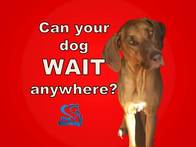
Change any part of the routine a little and the dog may seem to forget what the guardian intended wait to mean. The change could be waiting longer before releasing and the dog starts to eat before the verbal release. If one waits the same duration every time before giving a verbal release cue, the dog may be learning wait is specifically for four seconds and then he may eat. The guardian is assuming that it's the release cue the dog is using as the signal to eat. If one varies the time of waiting at each meal, the dog is more inclined to wait for some other cue to release. Another change could be that the dog can wait while someone stands next to him, but not if they walk away. This can occur if the dog is learning the pattern includes that walking away means it's OK to eat. So when one walks away before releasing, the dog is reading the physical signal that it's time to eat. (Who knows, maybe he thinks the trainer simply forgot to release!?) Pretty clever really. After all, he's always happily eating when you walk away. It could be any part of the wait routine that breaks down, even using a bone instead of a bowl; to the dog, wait may mean wait for "bowl" not bone!
The sad thing is, the reluctance to wait is often misinterpreted as a dog being wilfully disobedient, showing dominance or just plain old stupid. In fact it's usually none of these. It's more often a deficit in training and a misunderstaning between two individuals who don't speak the same language. One is trying to teach the other. Have you ever tried to communicate with someone from another country and they totally misunderstood your gestures? It can take a while to get the message across.
Teaching wait in every scenario may seem daunting and endless! The great news is that if you teach your dog a few differences (wait for longer, wait while I stand away from you, wait while I go out of sight, wait while another dog eats) they get better and quicker at generalizing what you mean each time. They get better at learning how to learn.
I enjoy training Zuri to wait before eating, at doors, at gates and before getting out of the car. I train at home and then I like to test if Zuri has understood it in a new, more demanding environment or context. Especially in more life-like set ups. I set up training sessions that replicate (or as close as possible) what might happen unexpectedly in the real world. For example, if she can wait while she is in the middle of eating something at home, I have a better chance of getting her to wait if she is eating something stinky on the beach. If she can resist bolting out of the car to greet and play with her favourite friends at the beach, there is a better chance of her waiting if a car unexpectedly drives past in the carpark as we are disembarking. If she succeeds during the test, brilliant! If not, it's not a failure. It's valuable information of what I need to work on in order to help her understand what I would like her to do in future.
Here's a video showing how I test to see what Zuri understands wait to mean: https://youtu.be/NYxoO8NhKpI

 RSS Feed
RSS Feed